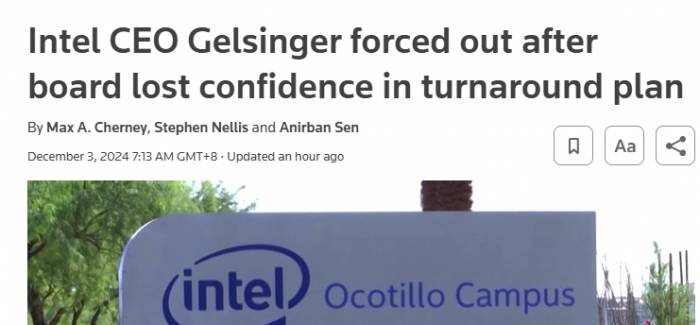On December 3rd, a significant leadership shakeup occurred at Intel, as reported by Reuters and numerous other media outlets. The company's CEO, Pat Gelsinger, announced his resignation, a move that has sent ripples of concern throughout the tech industry. Under his leadership for less than four years, Intel struggled to navigate its challenges, with a bold yet costly turnaround plan ultimately lacking the board's confidence, leading to Gelsinger's departure.
According to insider sources, Gelsinger's resignation came swiftly after a board meeting held last week. During this meeting, board members expressed their dissatisfaction with the changes implemented under Gelsinger's stewardship, criticizing the ineffectiveness of his strategies and the slow pace of transformation. Faced with mounting pressure from the board, Gelsinger opted to resign rather than face the possibility of being ousted or stepping away gracefully. His departure comes at a crucial time, as he was still in the midst of implementing a four-year roadmap aimed at reclaiming Intel's leadership in the computer chip manufacturing sector, a position it has lost to the Taiwan Semiconductor Manufacturing Company (TSMC).
Under Gelsinger's tenure, Intel experienced a dramatic decline in market capitalization, widening the gap to leading AI chip manufacturer Nvidia. The company not only lost contracts with key clients but also faced increasing challenges in meeting the product commitments it had made. Gelsinger's overly optimistic projections regarding potential AI chip transactions failed to materialize, resulting in Intel having to retract its recent revenue forecasts, further illustrating the strain the company was under during his time at the helm.
This significant transition at Intel undoubtedly marks a new chapter for the company. The board promptly appointed Chief Financial Officer David Zinsner and senior executive Michelle Johnston Holthaus as co-interim CEOs, while concurrently taking steps to actively search for a permanent replacement for Gelsinger. Notably, just days before Gelsinger's resignation, U.S. officials had awarded Intel a substantial $7.86 billion subsidy to support its transformation initiatives, highlighting a sharp contrast to the internal turmoil that was developing.
In a press release regarding Gelsinger's exit, Frank Yeary, the board's independent chair, mentioned that while Intel has made significant strides in restoring its competitiveness in manufacturing and creating a world-class foundry, much work remains to be done. The board is committed to rebuilding investor confidence, establishing a committee to seek a successor to Gelsinger promptly.
Adding to the uncertainty surrounding Intel’s future, insiders revealed that Karen Kahn, Intel's communications chief, is also planning to depart. This series of high-profile exits undoubtedly contributes to a climate of unpredictability for the tech giant as it navigates its next steps.
During Gelsinger's leadership, Intel announced various ambitious plans aimed at reversing its fortunes, including the construction of a $20 billion factory in Ohio and a significant hiring spree. However, these ambitious expenditures coincided with a collapse in the laptop and personal computer markets, causing Intel’s profit margins to plunge far below historical averages, and its stock price to continue its downward trajectory.

Market strategist Ryan Detrick of Carson Group pointed out that during Gelsinger's time, Intel's stock price plummeted by over 60%. Thus, his resignation did not come as a surprise to many. Detrick emphasized the pressing need for fresh leadership to steer the company back on course, as any major strategic decision made by Gelsinger was increasingly subject to rejection from the board.
Senior analyst Hans Mosesmann from Rosenblatt Securities underscored the urgent requirement for a tech giant like Intel to unleash cutting-edge products, revolutionary ideas, and precise execution. However, he lamented that during Gelsinger's tenure, these crucial elements did not come to fruition. According to Mosesmann, a significant misstep during Gelsinger's leadership was the inability to successfully launch a piece of AI chip technology that could effectively compete with Nvidia’s offerings. This failure has placed Intel in a disadvantaged position within the fast-growing AI market, causing it to miss out on numerous opportunities for advancement.
The implications of Gelsinger's resignation extend far beyond immediate leadership changes. They evoke reflections on the broader competitive landscape of the semiconductor industry, which is characterized by rapid innovation cycles and an unrelenting demand for high-performance chips. As Intel seeks new leadership, the challenge will be to not only regain its competitive edge but also to inspire a renewed sense of optimism among investors and tech enthusiasts alike.
Intel's current predicament serves as a cautionary tale of the pressures facing traditional semiconductor firms in the modern landscape, particularly as they contend with the likes of Nvidia and other agile competitors. It raises critical questions about the company's future direction, the strategies proposed by the next CEO, and how Intel can reclaim its storied legacy as a trailblazer in technology.
As the industry waits to see who will step into the role of CEO, stakeholders will be hoping for a leader capable of executing a vision that aligns with the rapid changes in consumer demand, technological advancements, and shifting market dynamics. The road ahead is undoubtedly arduous, but it is crucial for Intel to embark on this journey with renewed vigor and strategic foresight.
Leave a Comment